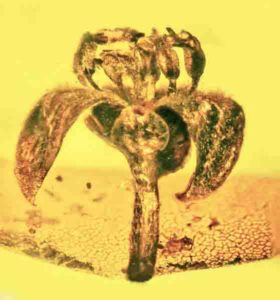
The compounds behind the perfumes and colognes you enjoy have been eliciting olfactory excitement since dinosaurs walked the Earth amid the first appearance of flowering plants, new research reveals.
Oregon State University entomologist George Poinar Jr. and his son Greg, a fragrance collector, found evidence that floral scents originated in primitive flowers as far back as 100 million years ago as pollinator attractants — a role they still play even though today’s flowers also have colorful petals for luring pollinators.
“I bet some of the dinosaurs could have detected the scents of these early flowers,” George Poinar said. “In fact, floral essences from these early flowers could even have attracted these giant reptiles.”
The Poinars examined amber flowers from Burma, including the now extinct glandular laurel flower (Cascolaurus burmensis) and veined star flower (Tropidogyne pentaptera).
The research revealed that the flower-based chemical compounds that are the basis for the perfumes and colognes we use today have been providing olfactory excitement to pollinating insects and other animals since the mid-Cretaceous Period.
Without colorful petals, flowers from that period had to rely solely on scents to attract pollinators.
“You can’t detect scents or analyze the chemical components of fossil flowers, but you can find the tissues responsible for the scents,” said George Poinar, professor emeritus in the OSU College of Science.
The floral secretory tissues producing these scents include nectaries, glandular trichomes, eliaphores and osmophores.
Nectaries are glands that produce fragrances and sweet deposits that insects love. Glandular trichomes are hairs with cells that make and send out scented secretory products. Eliaphores are stalked aromatic oil glands. oOsmophores, also known as floral fragrance glands, are cell clusters specializing in scent emission.
The study also found that secretory tissues of these Cretaceous flowers are similar in structure to those of their modern descendants. That suggests modern and ancient flowers of the same lineages produced similar essences.
Some of flowers studied were even in the process of emitting compounds at the time they were engulfed by the tree resin that later became amber.
The study also included a milkweed flower (Discoflorus neotropicus) and an acacia flower (Senegalia eocaribbeansis) in 20- to 30-million-year-old Dominican Republic amber.
The anther glands on the fossil acacia flower were especially attractive to bees, one of which was fossilized while visiting the stamens. Today, honeybees are still visiting acacia flowers that have the same type of flora glands that existed in the ancient past.
“It’s obvious flowers were producing scents to make themselves more attractive to pollinators long before humans began using perfumes to make themselves more appealing to other humans,” George Poinar said.
Reference:
George Poinar, Greg Poinar. The antiquity of floral secretory tissues that provide today’s fragrances. Historical Biology, 2018; 1 DOI: 10.1080/08912963.2018.1502288
Note: The above post is reprinted from materials provided by Oregon State University. Original written by Steve Lundeberg.










